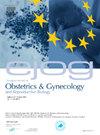Seizure prediction in pregnant women with epilepsy: An umbrella review of clinical practice guidelines and systematic reviews
IF 2.1
4区 医学
Q2 OBSTETRICS & GYNECOLOGY
European journal of obstetrics, gynecology, and reproductive biology
Pub Date : 2025-03-10
DOI:10.1016/j.ejogrb.2025.03.022
引用次数: 0
Abstract
Objective
To identify risk factors for seizure in pregnant women, and in the general population with epilepsy.
Study design
Umbrella review of clinical practice guidelines and systematic reviews on risk factors or prediction models for seizure occurrence in pregnant women with epilepsy, adults with epilepsy, or all individuals with epilepsy. Guidelines or systematic reviews exclusively for children were excluded. We searched MEDLINE, Emcare, Embase, CINAHL, TRIP PRO, Epistemonikos, World Health Organisation, Guideline International Network, DANS, and grey literature (2000-2023) without language restrictions. Risk factors or predictors listed in the final guidelines or systematic reviews were collated and thematically analysed.
Results
From 3406 citations, we included 13 articles (ten guidelines, three systematic reviews) reporting 26 risk factors in pregnant women and the general adult population with epilepsy: eight factors in guidelines for pregnant women only; five in both pregnant women and general adult populations (four in both guidelines and systematic reviews, one in guidelines only); and 13 factors in the general adult population (four in both guidelines and systematic reviews, eight in guidelines, and one in a systematic review). Risk factors were categorised into five broad themes: seizure type; seizure control; anti-seizure medication; neurological; and epilepsy and medical history. Three risk factors for seizure ocurrence were cited in more than two guidelines or systematic reviews: seizure freedom (reduced risk), immediate initiation of anti-seizure medication after first seizure (reduced risk), and abnormal electroencephalogram (increased risk). Three risk factors were linked to a more than two-fold chance of seizures in pregnant women with epilepsy: tonic-clonic seizures in the last three months (RR 7.20, 95% CI 6.63-11.93), a history of non-tonic-clonic seizures (RR 2.11, 95% CI 1.88—2.62), and seizures in the pre-pregnancy year compared to no seizures (RR 3.51, 95% CI 3.13-3.94).
Conclusion
Multiple risk factors have been recommended for use in practice across different guidelines and reviews to identify those at increased risk of seizures in the adult population with epilepsy, and specifically in pregnant women with epilepsy. Further research is needed on the implementation of tools for predicting seizures to improve maternal and neonatal outcomes.
求助全文
约1分钟内获得全文
求助全文
来源期刊
CiteScore
4.60
自引率
3.80%
发文量
898
审稿时长
8.3 weeks
期刊介绍:
The European Journal of Obstetrics & Gynecology and Reproductive Biology is the leading general clinical journal covering the continent. It publishes peer reviewed original research articles, as well as a wide range of news, book reviews, biographical, historical and educational articles and a lively correspondence section. Fields covered include obstetrics, prenatal diagnosis, maternal-fetal medicine, perinatology, general gynecology, gynecologic oncology, uro-gynecology, reproductive medicine, infertility, reproductive endocrinology, sexual medicine and reproductive ethics. The European Journal of Obstetrics & Gynecology and Reproductive Biology provides a forum for scientific and clinical professional communication in obstetrics and gynecology throughout Europe and the world.

 求助内容:
求助内容: 应助结果提醒方式:
应助结果提醒方式:


